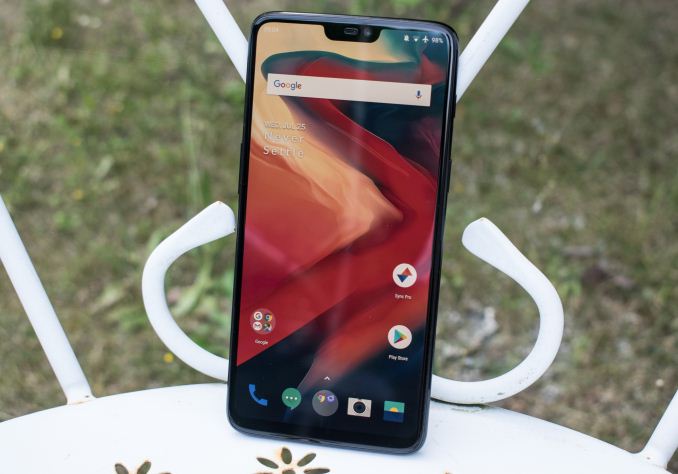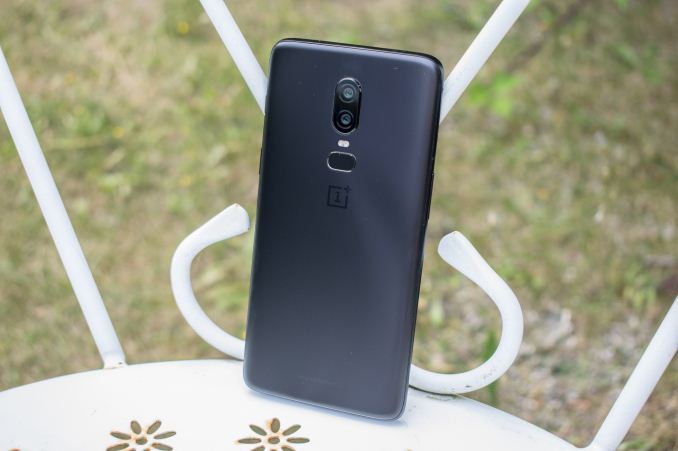The OnePlus 6 Review: Among The Best Of 2018
by Andrei Frumusanu on July 27, 2018 8:30 AM EST- Posted in
- Mobile
- Smartphones
- OnePlus
- OnePlus 6
Conclusion & End Remarks
The OnePlus 6 is a device that generally impressed me a lot. I was going into the review without any expectations or preconceptions as it was my first OnePlus device to more thoroughly review.
Design-wise, the OnePlus 6 marks a major change for the company as it employed a new industrial design. Most notably, this is visible in the back of the phone as the new glass cover marks a replacement for the previous metal chassis. The review unit which I’ve got had the new matte “Midnight black” variant which offers a sanded glass finish. I’ve actually really liked the finish as it feels very unique and is less of a fingerprint magnet than the usual glass back. Some people have noted that they didn’t like that it’s more slippery than the shiny glass variants – I can’t really comment on that other than saying that I personally didn’t have an issue with it.
The front of the phone also attracted a lot of attention due to the fact that OnePlus adopted a display notch in the OP6. As I’ve stated in past reviews such as Huawei’s P20’ pieces, I’ve actually had no issue at all with the notch. In practical terms it actually does offer more screen real-estate by having the notification icons and status icons where there usually would be phone bezel. You can black out the “ears” via a software option if you wish to and this works very well with the AMOLED screen, with only the occasional screen reflection reminding you that there’s actually a notch there.
The display of the OnePlus 6 is very good and has accurate colour profiles if that’s a requirement for you. Viewing angles are excellent, as is usual for an OLED display. The only two drawbacks here is that OnePlus by default doesn’t enable the high-brightness mode of which the hardware is capable of, and this comes at a detriment of legibility in bright scenarios such as direct sunlight. Also the screen resolution, while for most people might be sufficient, is for me personally too stretched out over the large screen and I would have really preferred the phone to come with a 1440p panel.
Performance of the OnePlus 6 is its absolute shining point as not only does it offer the same outstanding system performance that I’ve described in our Mi MIX 2S review, naming that one of the fastest devices I’ve ever experienced, but actually the OP6 also manages to distinguish itself from other Snapdragon 845 devices by having vastly superior sustained 3D performance. This latter, while I’m not exactly certain on the facts, is something that I want to attribute to a seemingly better thermal dissipation design on the OnePlus 6.
The camera on the OnePlus 6 also impressed me a lot in daylight shots. It was among one of the best cameras in terms of exposure, colour reproduction and resulting natural high dynamic range images. The 16MP shooter also was able to very much obtain some of the most detailed shots among current generation devices, although it was visible that OnePlus pushed quite hard in terms of the optics and the f/1.7 aperture, as we can discern some defects in the lens.
In night-time the OP6 did also well and is more than adequate as a shooter, although it’s hitting hardware boundaries as it just doesn’t have the same light capture abilities of other flagships.
The second sensor on the OP6 is one of very limited value as its only use-case is the depth perception within the portrait mode. Given that the bokeh blur is actually a computational effect applied in software, adding a second module just for depth perception is an expensive endeavour which doesn’t benefit the camera in any other capturing modes. I wish OnePlus had invested the resources into a wide-angle or telephoto lens instead.
Speaker wise, it’s probably one of the weaker phones out there as the sound quality is below other flagships. However the OnePlus 6 has a 3.5mm headphone jack – which can be make or break decision for a lot of buyers, so congratulations on OnePlus for keeping the option for the consumer.
The battery life of the phone is also excellent. It doesn’t top out the charts as it does only have a 3300mAh battery, but the SoC and screen are power efficient enough to make up for it.
Overall I think the OnePlus 6 is an excellent device, and while it’s not perfect, it offers incredible value at its price range and easily beats out any other contender. The Galaxy S9, in particular the Snapdragon variants, are still probably overall better devices, but also come at a price premium.
Generally I’ll easily recommend the OnePlus 6 to any buyer as I just don’t see any deal-breaking negatives that would make anybody regret purchasing the phone.












90 Comments
View All Comments
Total Meltdowner - Friday, July 27, 2018 - link
Art Photography? I'm not an unemployed liberal. I like phones to snap photos of family and friends doing things worth remembering.Cooe - Saturday, July 28, 2018 - link
Jesus Christ...Quantumz0d - Friday, July 27, 2018 - link
Starting with the wireless charging changing ergonomics and thickness, I refute. Look up at LG V30 - 7.3mm zero bump no notch. Has Qnovo on top of it, looks better made better with MIL spec. IP68 certified as well. OnePlus failed at Metal design with signal flaw with OP3/T and they cheaped out with glass just for marketing this time. About time when they ditch the jack. OPPO started that with their feeble built Find X.Too soft on Oneplus and other companies notch "there's really nothing controversial" its downright copied from Apple except that keeping the bottom bezel for no reason except to make it a marketing trash. Blacking it out for what ? Breaking the Android apps, but like all mainstream brainwashers Google also decided to add it with utter shameless act. Seems like even at AT no one cares about originality or engineering anymore. Shame
No mention of absence of Video out, Netflix certification. Same battery capacity since OP3T. And Axon 7 from 2016 is able to sell a 1440P AMOLED panel at same/less cost with more features like Stereo front facing. AKM DAC wgich works with Lineage. While OP cuts corners at all specs just increase the RAM and Memory that's it. Pixel 2XL shreds OP in speed with low RAM, not against it but this phone is hot garbage.
Oh this phone doesn't have USB3.0 either. CEO says no one uses when we have LTE pure BS. Why are they incl the high capacity UFS then ? Rubbish selfless corp. After being burned at the Op3 promised blobs and the worst part of this phone not mentioned, the T variant. Which makes the Op6 users look like fools, why don't this get mentioned anywhere ? Is OP paying that hefty ? Guess so since they skimp so much and price increase..its a disgrace.
Sultanxda left OP because they never bother to fix the camera or treat it as some high profile golden IP, or the 821 3T high clock crash. Dash charging, another proprietary technology, no way you can find replacement parts for this phone because 5-6Month EOL is extreme ripping.
dshess - Friday, July 27, 2018 - link
I wish one of the second-tier vendors would commit to long-term hardware support. At $600 (or $800), the story is when they manage to make a phone that sucks - but making an excellent phone for $250 is a great story, especially if you can still purchase the same device a few years later. It's like nobody is even trying to take on the iPhone.icalic - Friday, July 27, 2018 - link
Hi @Andrei Frumusanu,why no more gfxbench manhattan es 3.1 / metal test for battery life and final frame rate @ 200 nits?
i think that test is good for us to look GPU efficiency on every device.
for oneplus 6, i suspect high sustained gfxbench followed by higher power consumption than other snapdragon 845 devices.
Andrei Frumusanu - Friday, July 27, 2018 - link
Power consumption between devices doesn't really change. In this regard I'm keeping the power measurements to the initial SoC reviews of the first devices. The power I measured on the OP6 was not much different than on the S9+ which is covered here: https://www.anandtech.com/show/12520/the-galaxy-s9...The final frame rate benchmark has been superseded by the sustained performance measurements across all 3D workloads, so there's no need for a separate metric.
As for battery measurement in 3D workloads, I think the GFXBench test as an actual *battery* test didn't really convey a lot other than a maximum rundown test. I think having a phone loop in an actual commonly released game would be better representative. As a reminder, the SoC's power consumption will differ greatly at different frequencies and real games will be Vsync capped at 60fps, so in actual use-cases the MH3.1 battery test didn't really show a representation of such use-cases. Currently I'm still thinking about a way to do this better and hopefully the methodology will evolve, but for now it's as it is due to practical reasons.
arvindgr - Friday, July 27, 2018 - link
In OnePlus 3 review, AT included note on USB, that they're still using USBv2! But 4 generations later OP6 still packs that same USBv2 tech. Also with Oppo proprietary charging tech, they are least bothered about USB-PD standards which its SoC supports via QCv4. Why such tech implementations weren't discussed at all..?Andrei Frumusanu - Friday, July 27, 2018 - link
USB 3.0 has issue with creating radio frequency interference in the 2.4GHz band which requires vendors to do a lot more engineering in terms of shielding, that's why a *lot* of phones don't support it.In regards to fast charging techniques - first of all ever since I came back to AT I haven't had the opportunity to re-test all the devices over the last year that we were missing data on. Secondly I didn't prioritise this as much because I feel after 5V/2A/10W which essentially every device nowadays supports, faster charging rates become diminishingly relevant.
Batteries are supposed to be charged at a maximum of 1C, for the OP6 that's for example 3.3A since the capacity is 3.3Ah. A 10W charger is already 2.38A, going to 15W is getting near the limit. Devices nowadays also have like 10 different charging profiles depending on what power supply you connect to it, so while true we can resume testing the stock charger, but again in reality how representative is that really for most people, especially among AT readers?
Quantumz0d - Friday, July 27, 2018 - link
Appreciate the response for this. I always wonder what's the reason behind cutting costs for USB spec. And about the Dash charge, it's proprietary you are stuck with using the accessories from OP site only and usable with their HW only. Its not about speed its about adopting standards like USB PD or QC.Andrei Frumusanu - Friday, July 27, 2018 - link
> Its not about speed its about adopting standards like USB PD or QC.I think that's a weird attitude to take. QC or PD are just ways to achieve speed. A 10W 2A non-standard charger will charge the same as a 10W QC, PD, Dash or whatever charger. Electrons don't care about the standard.